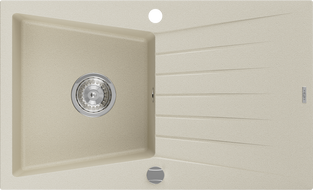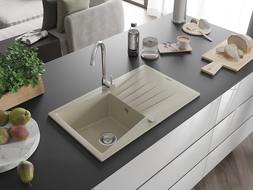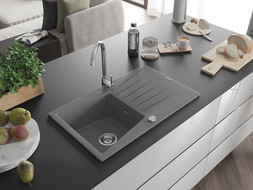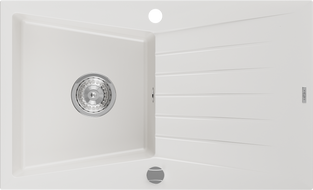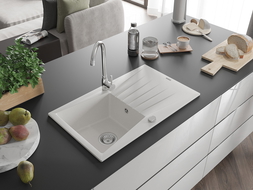
Granite sinks are known for their incredible durability and resistance to mechanical damage. Their unique physical properties are complemented by elegant design – it's hard to find such an impressive kitchen feature. If you want your sink to last for many years in unchanged condition, you must remember regular cleaning and maintenance. Granite, although resistant to scratches and damage, is not indestructible! So, how to clean a beige granite sink?
What will you learn from this text?
Having a beige granite sink, although not only a popular example, can be a practical but unfortunately also problematic kitchen solution – especially when it comes to cleaning. From our text you will learn:
-
What should not be forgotten when cleaning a granite sink.
-
Which home cleaning methods are worth using.
-
How often this activity should be carried out.
Granite sink – what is it made of?
Granite sinks, also known as quartz or stone sinks, are products made from a composite – a mixture of quartz and epoxy resin. The resin hardens and increases resistance to high temperatures, while quartz provides the unique stone appearance of the sink. Manufacturers offer two basic types of sinks – single and double bowl. To achieve the highest functionality of the design, manufacturers often offer different bowl sizes and decide to introduce useful indentations for storing sponges or dishwashing liquid.
Daily cleaning of a granite sink – how to do it?
Cleaning a granite sink doesn't have to be difficult. To keep its surface in perfect condition, just follow simple care recommendations. The absolute basic is daily washing of the granite sink with dishwashing liquid. Remember to use an ordinary soft sponge moistened with warm water. By following this daily care routine, you can ensure that the granite sink will look new even after many years of use.
Cleaning granite sinks - what to remember!
Although granite sinks are resistant to scratches, they should not be cleaned with a scouring pad or rough sponge. It's also worth remembering that even regular cleaning of the granite sink with dishwashing liquid won't prevent discoloration or tea deposits. We advise cleaning the sink occasionally with a special cleaner for granite sink. These specialty agents will remove all stubborn dirt, including oil stains. To get rid of streaks, it's good to use a spray containing fat-emulsifying substances. One should also remember to use products designed for granite surfaces, as only these won't damage the granite sink coating and remove limestone accumulating on the sink surface.
Eco-friendly cleaning of a granite sink – baking soda
If someone prefers natural cleaning methods, they should definitely get baking soda. Add a decent amount of product to a bowl and mix it with a small amount of water. For even better results, you can mix the soda with vinegar. After applying the mixture, simply leave it on the granite surface and after a few minutes, rinse with warm water.
What color of granite sink to choose?
A beige granite sink is much more difficult to maintain than a black one, so before making a final purchase decision, weigh the "pros" and "cons". Aesthetics don't always align with functionality, so it's good to consider choosing a more universal solution. However, if someone decides on a beige granite sink, they should remember to clean it each time after pouring a liquid with a strong dye saturation – this particularly applies to:
-
coffee,
-
tea,
-
beetroot juice.
It's also necessary to remember that liquids with a high amount of dye are particularly difficult to clean, so you shouldn't let them dry and penetrate the microstructures on the surface. One also can't forget the systematic care of the granite sink surface – granite sinks are quite resistant to mechanical damage and don't easily discolor, but you need to take proper care of them.
Sealing a granite sink – why is it important?
Sealing a granite sink is one of the most important maintenance stages, which helps protect the surface from moisture, stains, and dirt. Sealing the sink involves applying a special impregnating agent, which creates an invisible protective layer on the granite sink surface. As a result, the sink surface becomes less prone to limestone build-up or discoloration from coffee, tea, or oil. How to seal a black sink? The process is similar – you need to use a product for granite sinks, applied with a soft cloth, and after some minutes, polish with a dry cloth. Sealing a granite sink should be carried out every 6–12 months, depending on usage intensity.
Maintaining a granite sink with oil
Some users opt to maintain their granite sink with oil, especially with darker shades, such as black or graphite. Using mineral oil or special granite oil can help maintain the deep color and gloss of the granite sink. The oil should be applied sparingly to a dry surface, then thoroughly polished with a soft cloth. This type of maintenance not only enhances aesthetics but also further protects the surface from stains.
How to clean a beige granite sink?
How to clean a beige granite sink? Beige sinks are particularly prone to visible discoloration, so they require special attention. To clean a beige granite sink, it's worth regularly using gentle cleaning agents, such as dishwashing liquid or a baking soda solution with water. For more difficult stains, such as coffee or tea deposits, a 1:1 vinegar solution with water can be used. It's important not to leave stains on the surface for too long, as they can penetrate the structure of the beige granite sink.
Ways to clean sinks in light colors (and not only)
A white granite sink – cleaning requires as much caution as beige models. White sinks are prone to rust, grease, or food dye stains. To clean a white sink, it's worth using gentle agents designed for granite or home methods, such as a baking soda paste. Regular cleaning can help avoid permanent discoloration, which can be difficult to remove from the light surface.
Cleaning a stone sink – additional tips
Cleaning a stone sink, including granite, requires avoiding aggressive chemical agents, such as bleaches or products containing ammonia. Instead, it's worth using specialized products or home solutions, like vinegar or baking soda. What to clean a granite sink with? It's best to choose neutral pH products, which won't damage the protective coating of the granite sink.
Can you paint a granite sink?
Although it's technically possible, it is not recommended. Painting a granite sink can affect its functionality and durability, and the paint may not withstand daily use, contact with water, or detergents. Instead of painting, a better solution is sealing the sink. You can also decide to restore a granite sink.
Practical tips for daily granite sink care
To keep a light granite sink looking new, it's worth adhering to a few simple rules.
-
After each use, the sink should be cleaned with a soft sponge and dishwashing liquid, to remove food residues or grease.
-
Once a week it's a good idea to conduct a thorough cleaning of the granite sink, using baking soda or a specialized product.
-
Every few months, sealing the granite sink with oil is necessary to protect the surface from stains and damage.
With these simple steps, a granite sink will be not only functional but also aesthetic for many years. For more "tricks" in arrangements, we recommend reading our blog, where we write about, for example, what kind of water filter to choose for under the sink.



















